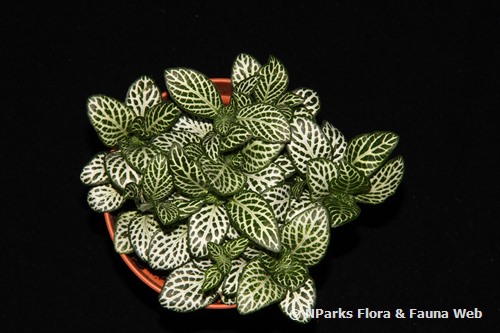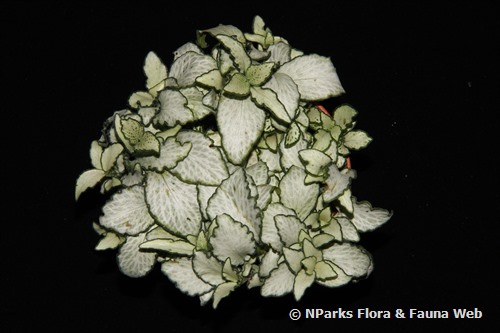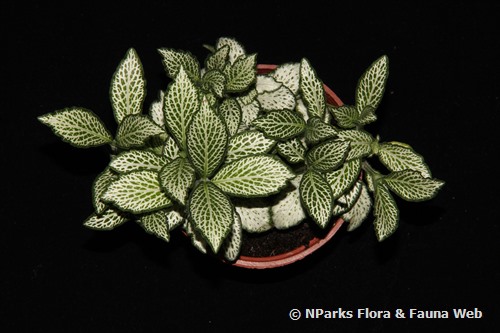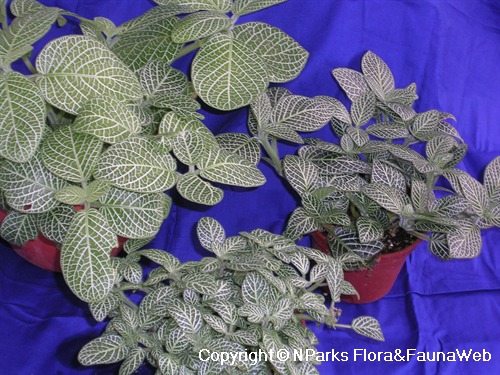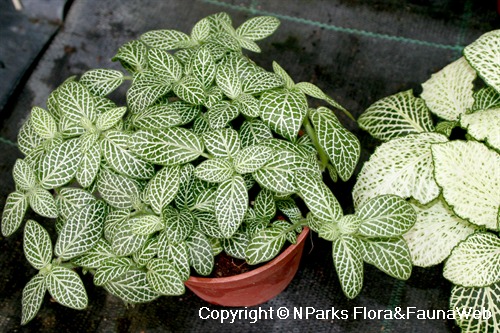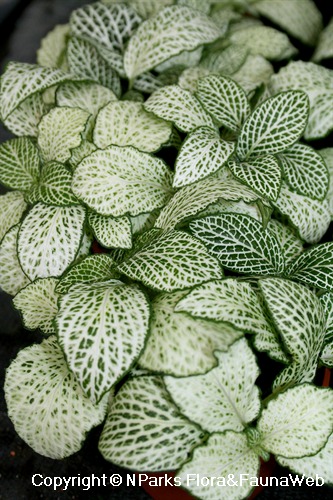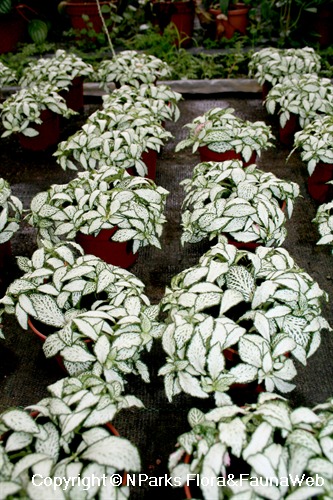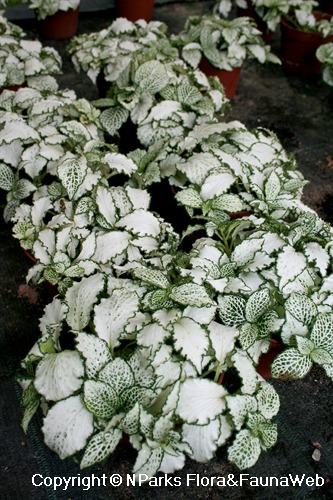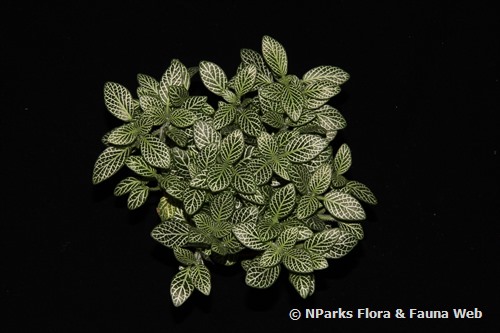
Back
Fittonia albivenis (Argyroneura Group)
| Family Name: | Acanthaceae |
| Synonyms: | Acanthus albivenis, Fittonia verschaffeltii var. argyroneura, Fittonia argyroneura, |
| Common Name: | White Nerve Plant, Mosaic Plant, Silver Fittonia, Silver Nerve, Silver Threads, Silver-net Plant, Snakeskin Plant, Nerve Plant, 白网纹草, 银网草, 网格草 |
Name
Classifications and Characteristics
| Plant Division | Angiosperms (Flowering Seed Plants) (Dicotyledon) |
|---|---|
| Plant Growth Form | Herbaceous Plant, Creeper |
| Mode of Nutrition | Autotrophic |
| Plant Shape | Shrubby |
| Maximum Height | 0.1 m to 0.2 m |
| Maximum Plant Spread / Crown Width | 0.5 m |
Biogeography
| Native Distribution | Brazil, Bolivia, Colombia, Ecuador, Peru |
|---|
Description and Ethnobotany
| Growth Form | Herbaceous shrub, up to 15cm height, creeping and rooting at lower nodes. |
|---|---|
| Foliage | Leaves around 5cm long, velvety texture, green with dense network of reticulated white veins. |
| Stems | Stems covered with fine white hairs. |
| Flowers | Flowers yellowish to cream-coloured, tubular, 2-lipped, insignificant, produced in congested spike inflorescence with overlapping green bracts. |
| Others - Plant Morphology | Ethymology: Genus epithet 'Fittonia' named in honour of Elizabeth and Sarah Mary Fitton, 19th century authors of 'Conservations on Botany'. Species epithet 'albivenis' means 'white veined', a reference to the net-variegated leaves. |
| Cultivation | Requires high humidity. Likes well-drained, loamy soils rich in organic matter. Water regularly to prevent withering, but avoid overwatering which may cause yellowing of leaves. Waterlogged soils may promote leaf and stem rot. Pinch off stem-tips to promote bushier growth. If grown for striking foliage, flower inflorescences may be removed. Propagate by stem cuttings, layering or division. |
Landscaping Features
| Desirable Plant Features | Ornamental Foliage |
|---|---|
| Landscape Uses | Terrarium, Container Planting, Indoor Plant |
Fauna, Pollination and Dispersal
| Seed or Spore Dispersal | Abiotic (Explosive Dehiscence), Biotic (Fauna) |
|---|
Plant Care and Propagation
| Light Preference | Semi-Shade |
|---|---|
| Water Preference | Moderate Water |
| Plant Growth Rate | Slow |
Foliar
| Foliage Retention | Evergreen |
|---|---|
| Mature Foliage Colour(s) | Green, White |
| Mature Foliage Texture(s) | Velvety / Furry / Tomentose |
| Foliar Type | Simple / Unifoliate |
| Foliar Arrangement Along Stem | Opposite |
| Foliar Shape(s) | Non-Palm Foliage (Oval) |
| Foliar Venation | Pinnate / Net |
| Foliar Margin | Entire |
| Foliar Apex - Tip | Obtuse, Rounded |
| Foliar Base | Truncate / Square |
| Typical Foliar Area | Notophyll ( 20.25cm2 - 45 cm2 ) |
| Leaf Area Index (LAI) for Green Plot Ratio | 4.5 (Shrub & Groundcover - Dicot) |
Non - Foliar and Storage
| Stem Type & Modification | Herbaceous |
|---|---|
| Root Type | Underground (Fibrous Root) |
Floral (Angiosperm)
| Flower & Plant Sexuality | Bisexual Flowers |
| Flower Colour(s) | Cream / Off-White, Yellow / Golden |
|---|---|
| Flower Symmetry | Bilateral |
| Inflorescence Type | Spike |
| Flowering Habit | Polycarpic |
Fruit, Seed and Spore
| Fruit Classification | Simple Fruit |
|---|---|
| Fruit Type | Dehiscent Dry Fruit , Capsule |
Image Repository
Others
| Master ID | 722 |
|---|---|
| Species ID | 2017 |
| Flora Disclaimer | The information in this website has been compiled from reliable sources, such as reference works on medicinal plants. It is not a substitute for medical advice or treatment and NParks does not purport to provide any medical advice. Readers should always consult his/her physician before using or consuming a plant for medicinal purposes. |

